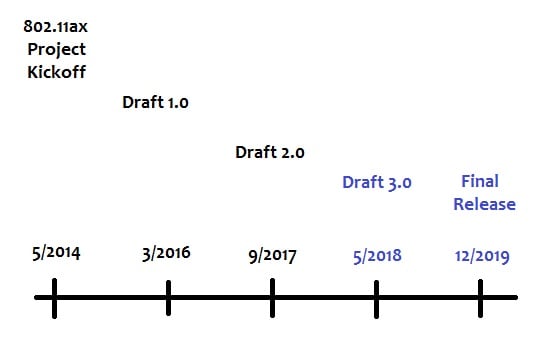The next iteration of WLAN protocols is due to release next year. Here's a look at IEEE 802.11ax-2019 and why it's needed.
The
latest WLAN IEEE standard is referred to with several epithets:
High-Efficiency Wireless (HEW), Next Generation Wireless, the "New WiFi"
standard, etc. All of these names convey the expectation of something
different.The 802.11ax project started May 2014. As shown in Figure 1, the standard is scheduled for final release in late 2019.

Figure 1. The current timeline for the development and release of 802.11ax
The Need for HEW
The IEEE 802.11 standard covers Wireless Local Area Networks (WLANs) operating in the unlicensed 2-6 GHz spectrum. The current published standards, 802.11n (802.11n-2009) and 802.11ac are for the following spectrums and have the following speeds associated with them.
While each brought new methods, techniques, and technology to carry more data over the airwaves, as soon as 802.11ac was published, the IEEE knew there was still work to be done.
As good as the existing standards are for traditional single-user environments, when a large number of users were located in specific areas (like an airport or stadium), less than desirable things were happening to the Wi-Fi signals for that area.
The large number of Access Points (APs) required for coverage and the dense concentration of devices/stations caused contention and interference; networks serving the environment degraded and slowed for everyone. The medium access layer (MAC) of these standards rely on a Carrier Sense Multiple Access with Collision Avoidance (CSMA/CA) scheme to control access to the airwaves.
With this 'collision detected/back off/try again' scheme, handling a lot of devices invites problems; the more devices trying to connect, the more collisions, the more degradation users experience. (Think of a planeload of passengers arriving at a terminal with all their devices searching for connections at once...) New MAC techniques will minimize collisions.
In addition to handling dense concentrations of users, improved Wi-Fi is needed for the growing number of devices associated with smart homes, wireless offices, and gaming. Even households can see their current routers max out when two or three streaming applications are in use. Improvements in the physical layer (PHY) will increase throughput for multiple users.
The Start
With these use cases in mind, the IEEE set out to design a standard that focused on how users experienced their Wi-Fi and overall network capacity. In May 2013, they asked their members if there was support for “high-efficiency WLAN”. The intent was to "enhance 802.11 PHY and MAC in 2.4 and 5GHz."
A slide from the IEEE's presentation on 802.11ax.
The solicitation for support highlighted "spectrum efficiency and area throughput" as goals for the new standard, as well as "real world performance". These goals reflect the changing needs for Wi-Fi: more load, more efficiency, and more reliability, even in the face of increasing interference and various deployment environments.
Expectations for 802.11ax
The HEW 802.11ax standard will replace both 802.11n and 802.11ac, becoming a high-efficiency WLAN standard for both 2.4G and 5G networks and focusing on multi-user environments. The standard is also expected to be backward compatible with previous standards.In addition to incorporating techniques found in other Wi-Fi and cellular technologies, it has the advantage of having both the 2.4G and 5G networks available, which could be used in combination to provide even more capacity.
The requirements include direction for "at least one mode of operation capable of achieving at least four times improvement in the average throughput per station in a dense deployment scenario, while maintaining or improving the power efficiency per station." It is reported to offer up to 10 Gigabit speeds.
In addition to handling MAC contention, the new standard includes:
- OFDMA (Orthogonal Frequency-Division Multiple Access) multiplexing
- MU-MIMO (Multiple-user multiple input/multiple output) antennas and beamforming
- 1024-QAM (Quadrature Amplitude Modulation)
- Target Wake Time (TWT), doze states, and load balancing

OFDM vs OFDMA. Image courtesy of National Instruments.
802.11ax uses MU-MIMO (multiple-user multiple input/multiple output) antennas to provide higher data rates. Previous standards used single-user MIMO where the multiple antennas connected to devices that were serviced sequentially. MU-MIMO enables these connections to be handled concurrently. Additionally, beamforming detects where connected devices are located and increases signal strength specifically in their direction to improve range.
Improved QAM boosts carrier efficiency. QAM is a digital modulation technique that incorporates both amplitude and phase modulation. In a very simple system, if you have 2 signals, shift one by 90 degrees to the other, you could transmit them both on the same carrier without interference and recover them at the receiver. 802.11ac uses 256-QAM modulation; 802.11n uses 64-QAM modulation and 802.11ax uses 1024-QAM modulation. By modulating 1024 different signals over the same frequency four times the efficiency of 802.11ac is realized.
APs can control and balance connections across the network using load balancing and dynamic sensitivity. Instead of one AP attempting to respond to every connection request, these techniques direct APs to not to respond if another AP in the network can provide a better connection or if making a connection would exceed the expected load requirements.
APs can use TWT with doze states to also improve congestion and device battery life. TWT allows APs to schedule times for devices to access the network; they can go into a doze state until the wakeup time. Scheduling allows network traffic to be optimized and with devices in a sleep state until their scheduled appointments, device battery life can be extended.
The Wait
To actually experience the speed and features of 802.11ax, the entire network has to implement the standard: APs, routers, and individual devices. Early release chipsets have been announced, as well as some equipment.The Wi-Fi Alliance is expected to start certification in early 2019 but everyone is already looking forward to HEW Wi-Fi now.






No comments:
Post a Comment